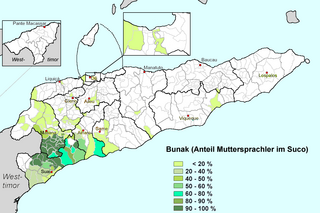Bunak language
| Bunak | |
|---|---|
| Native to | Trans–New Guinea ?
|
| Official status | |
Recognised minority language in | |
| Language codes | |
| ISO 639-3 | bfn |
| Glottolog | buna1278 |
| ELP | Bunak |
 Distribution of Bunak in East Timor (West Timor not shown) | |
The Bunak language (also known as Bunaq, Buna', Bunake, pronounced [bunaʔ]) is the language of the
Tetum
.
Bunak distinguishes between animate and inanimate noun classes.[3]
Phonology
| Labial | Alveolar | Palatal | Velar | Glottal | ||
|---|---|---|---|---|---|---|
Plosive/
Affricate |
voiceless | p | t
|
tʃ | k | ʔ |
| voiced | b | d
|
ɡ | |||
Fricative
|
voiceless | s | h | |||
| voiced | z | |||||
| Nasal | m | n
|
||||
| Trill | r
|
|||||
| Lateral | l
|
|||||
| Approximant | w | |||||
- Plosive sounds /p t k/ can be heard as unreleased allophones [p̚ t̚ k̚], in word-final position.
- Sounds /b d ɡ/ can be heard as [β r ɣ] in intervocalic positions.
- /ɡ/ can be heard as [dʒ] when preceding /i/.
- /z/ can have allophones [ʒ dʒ] in free variation.
- /tʃ/ is heard as [s] when preceding /i/.
- /l/ in word-final position can also be heard as a fricative [ɬ] in free variation.[4]
| Front | Central | Back | |
|---|---|---|---|
High
|
i | u | |
| Mid | e | o | |
Low
|
a |
Pronouns
Pronouns seem to tie Bunak more closely to the
East Timor languages
. The independent pronouns and object prefixes, which appear to retain the proto-Trans–New Guinea dual suffix *-li, are as follows:
| singular | dual | plural | ||
|---|---|---|---|---|
| 1st person | exclusive | ne-to n- |
ne-li n- |
ne-i n- |
| inclusive | i-li ∅- |
i ∅- | ||
| 2nd person | e-to ∅- |
e-li ∅- |
e-i ∅- | |
| 3rd person | animate | himo g- |
– | hala'i g- |
| inanimate | homo | |||
Notes
- ^ Bunak at Ethnologue (18th ed., 2015) (subscription required)
- ^ "New Guinea World, West Bomberai". Archived from the original on 2020-02-29. Retrieved 2018-05-20.
- ISBN 978-3-11-028642-7.
- ^ Schapper (2009).
References
- Schapper, Antoinette (2009). Bunaq: A Papuan Language of Central Timor (Ph.D. thesis). Australian National University. hdl:1885/150147.
- Schapper, Antoinette (2011a). "Crossing the border: Historical and linguistic divides among the Bunaq in central Timor". Wacana, Journal of the Humanities of Indonesia. 13 (1): 29–49. .
- Schapper, Antoinette (2011b). "Finding Bunaq: The homeland and expansion of the Bunaq in central Timor". In McWilliam, Andrew; Traube, Elizabeth G. (eds.). Land and Life in Timor-Leste: Ethnographic Essays. ANU Press. ISBN 978-1-921862-59-5.
- Schapper, Antoinette (2022). A Grammar of Bunaq. Mouton Grammar Library. Vol. 86. Mouton deGruyter. ISBN 9783110714500.
External links
- ELAR archive of Zapal, an oral literature genre of the Bunaq Lamaknen
- Timothy Usher, New Guinea World, Bunaq
